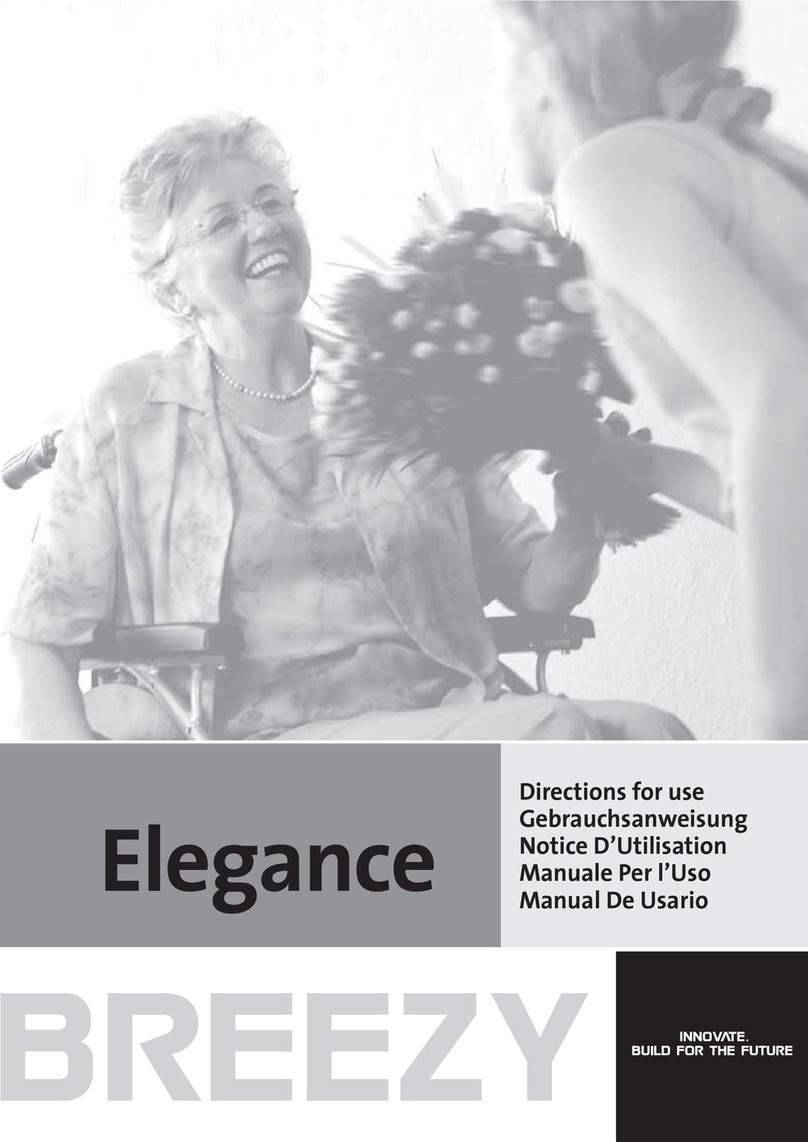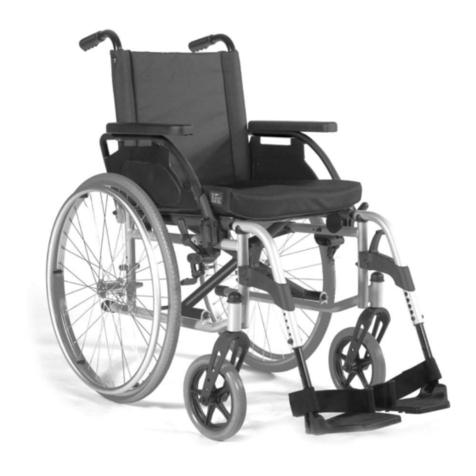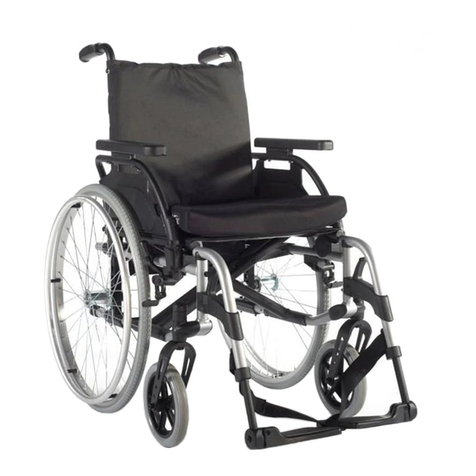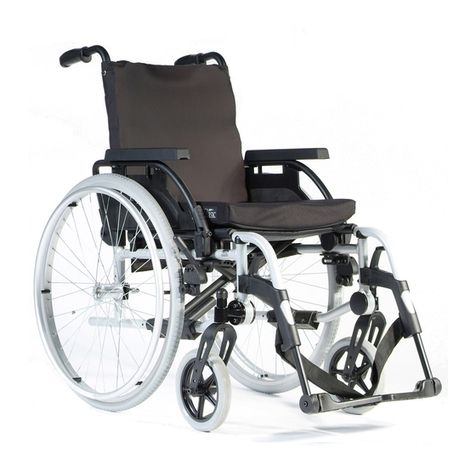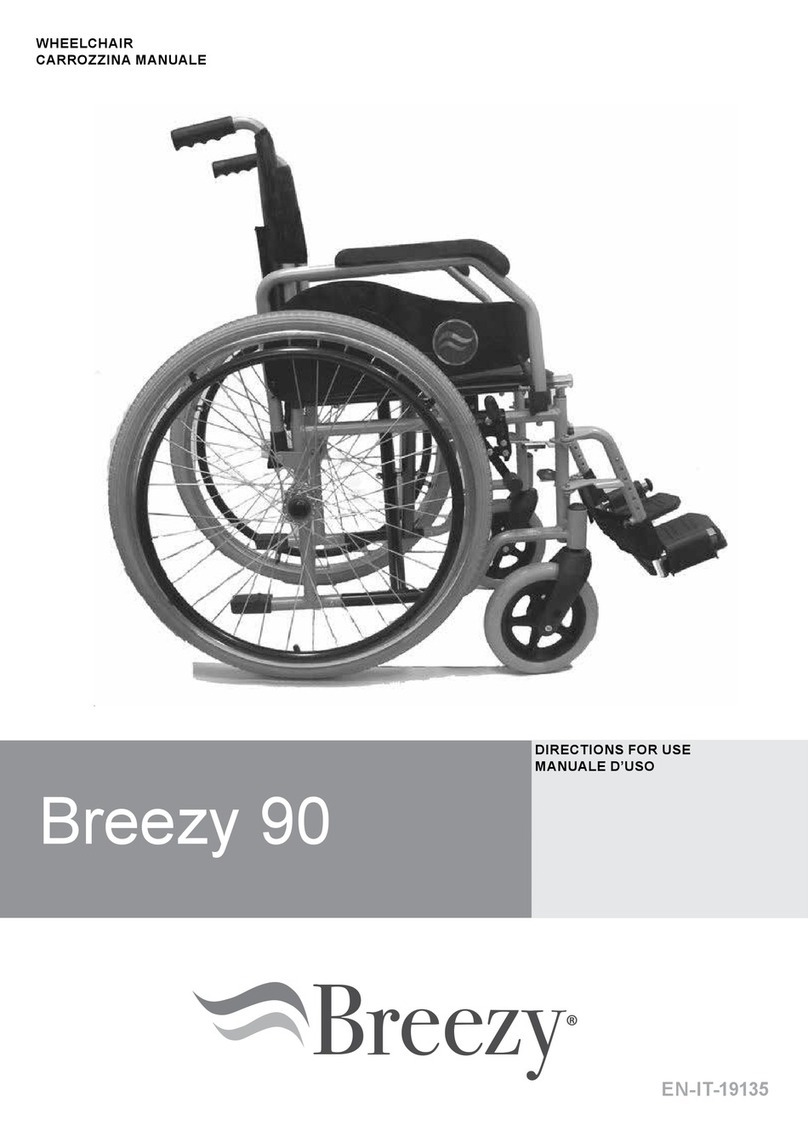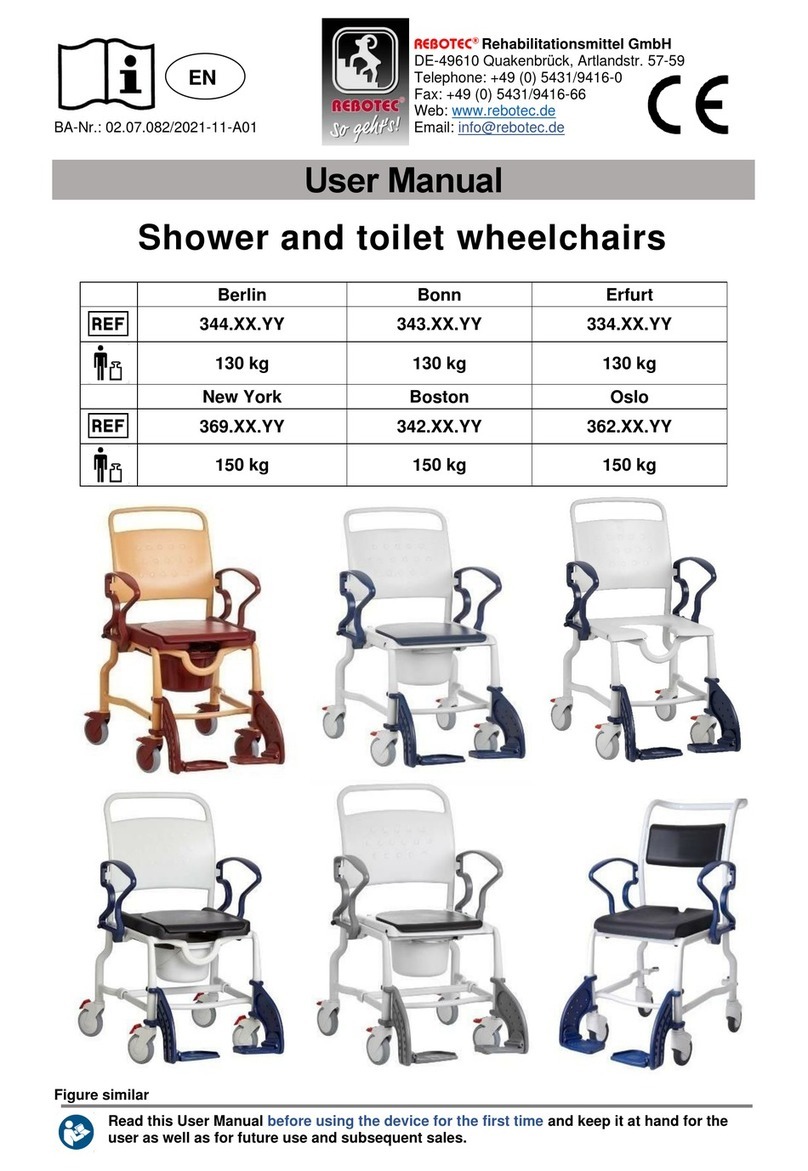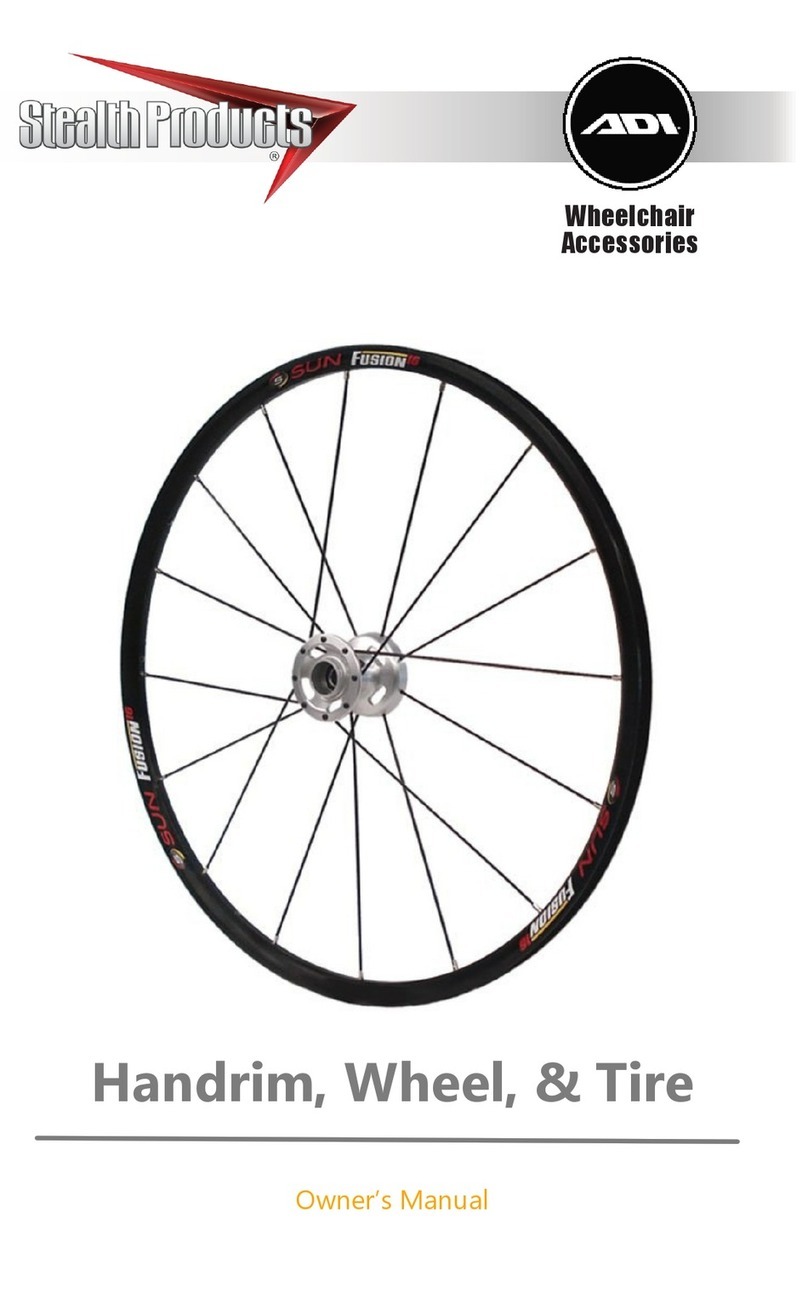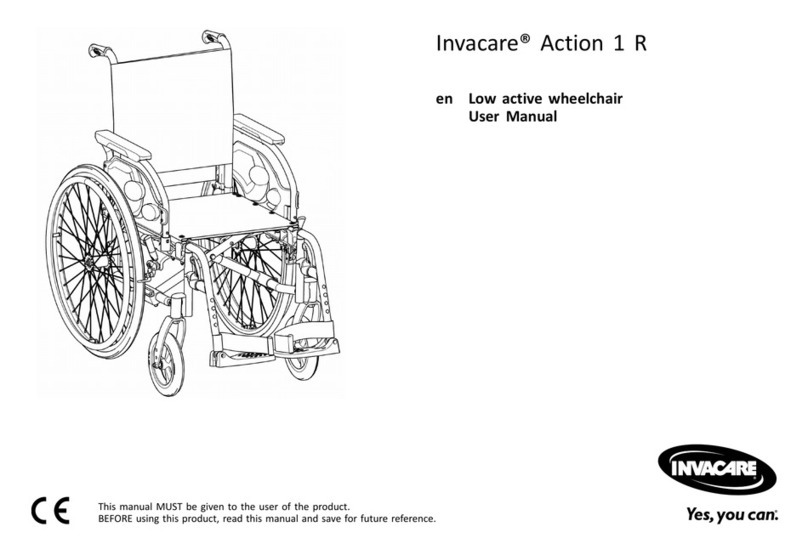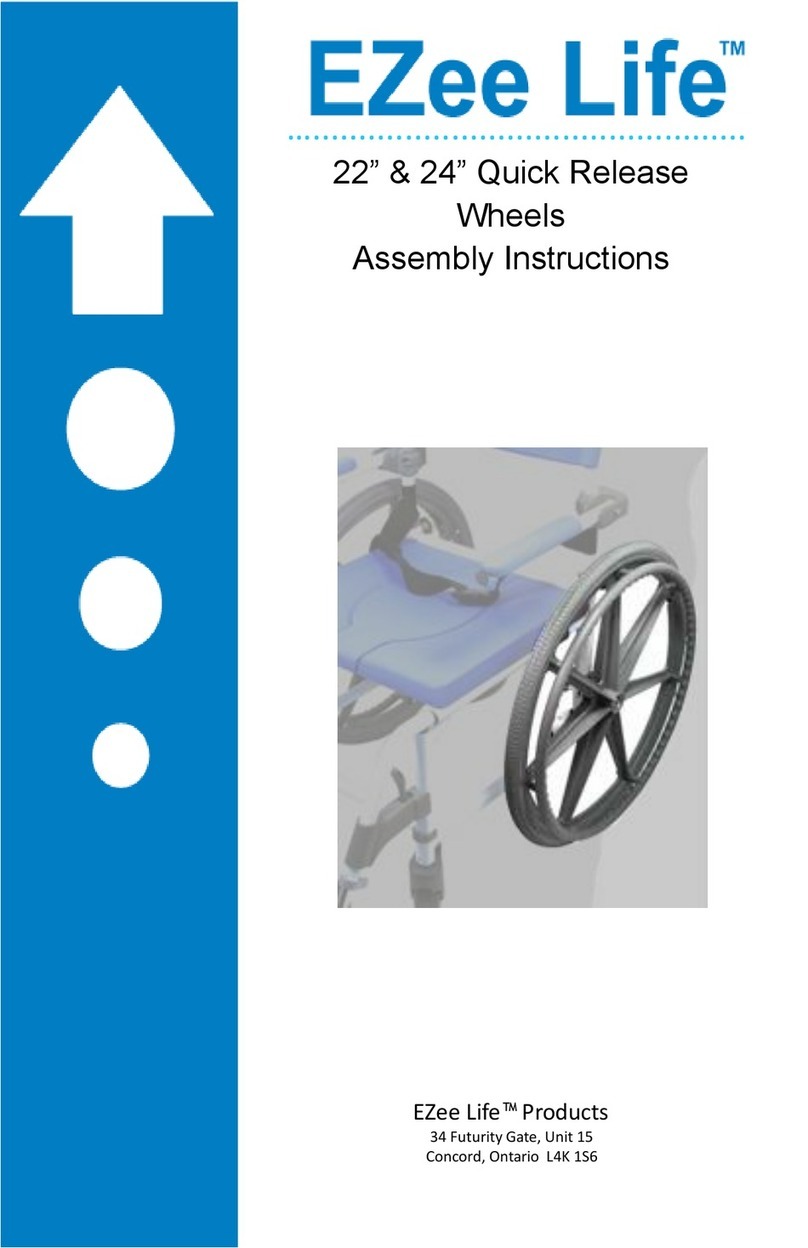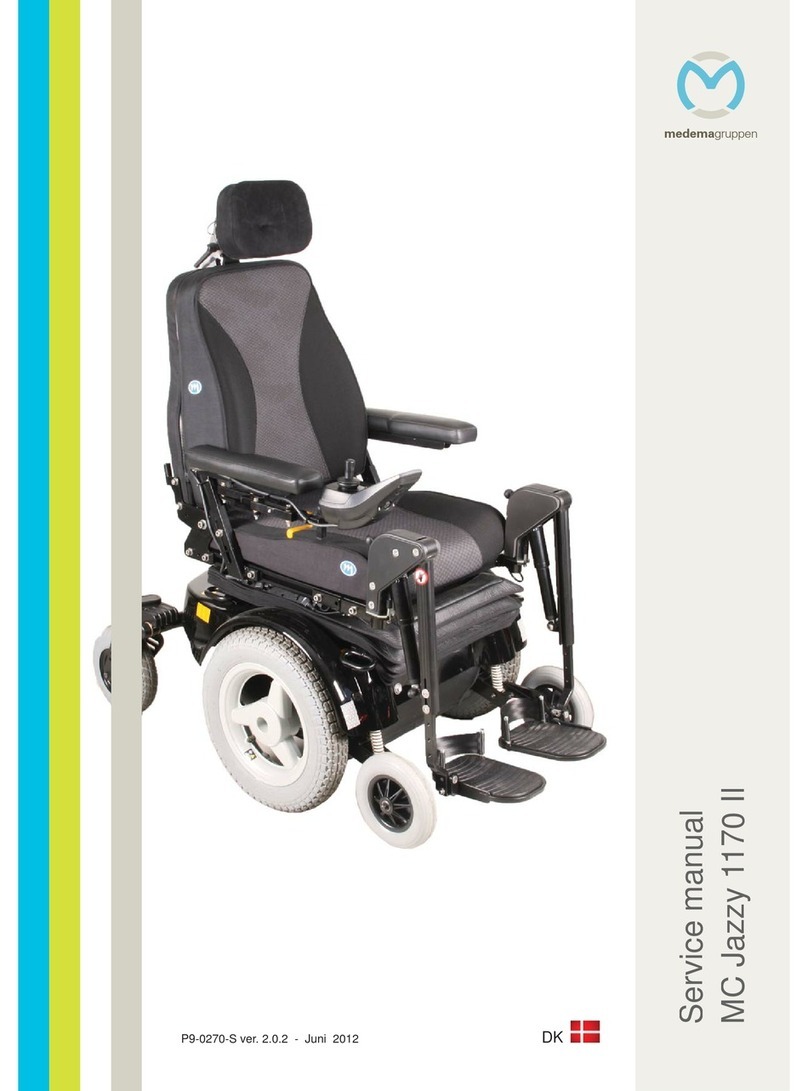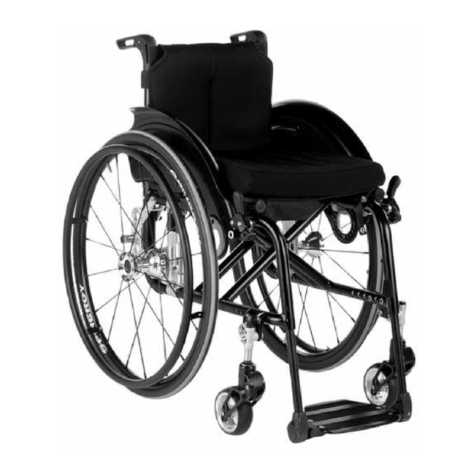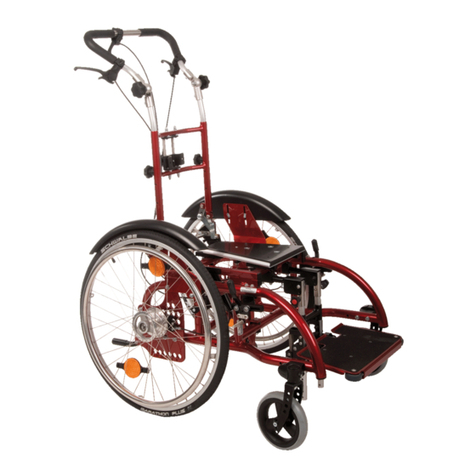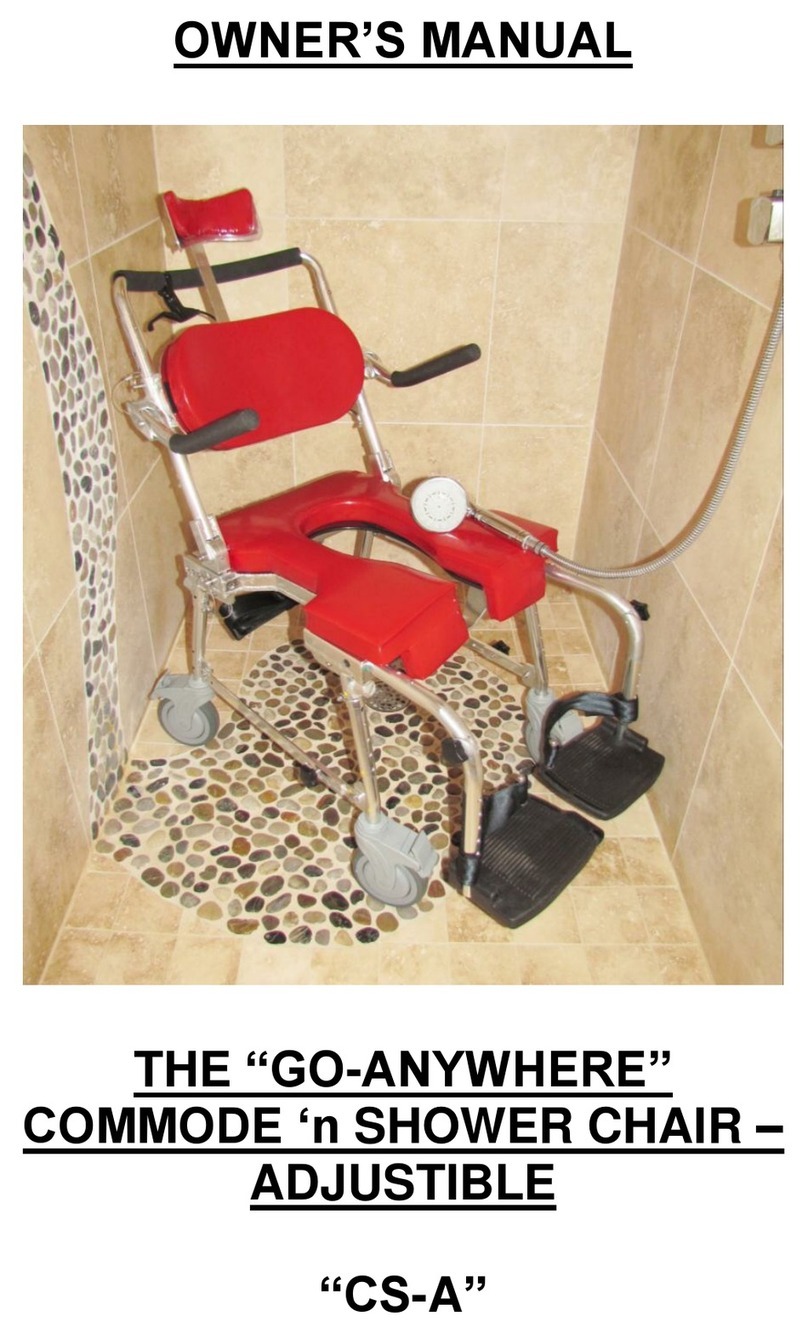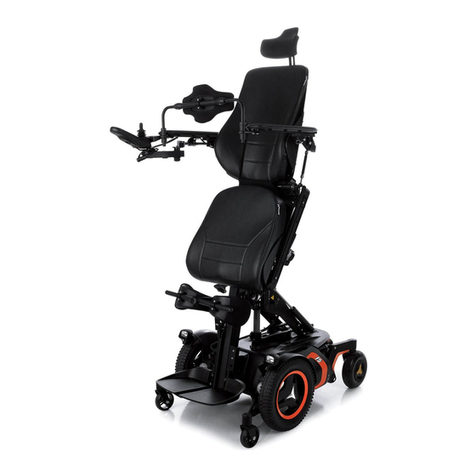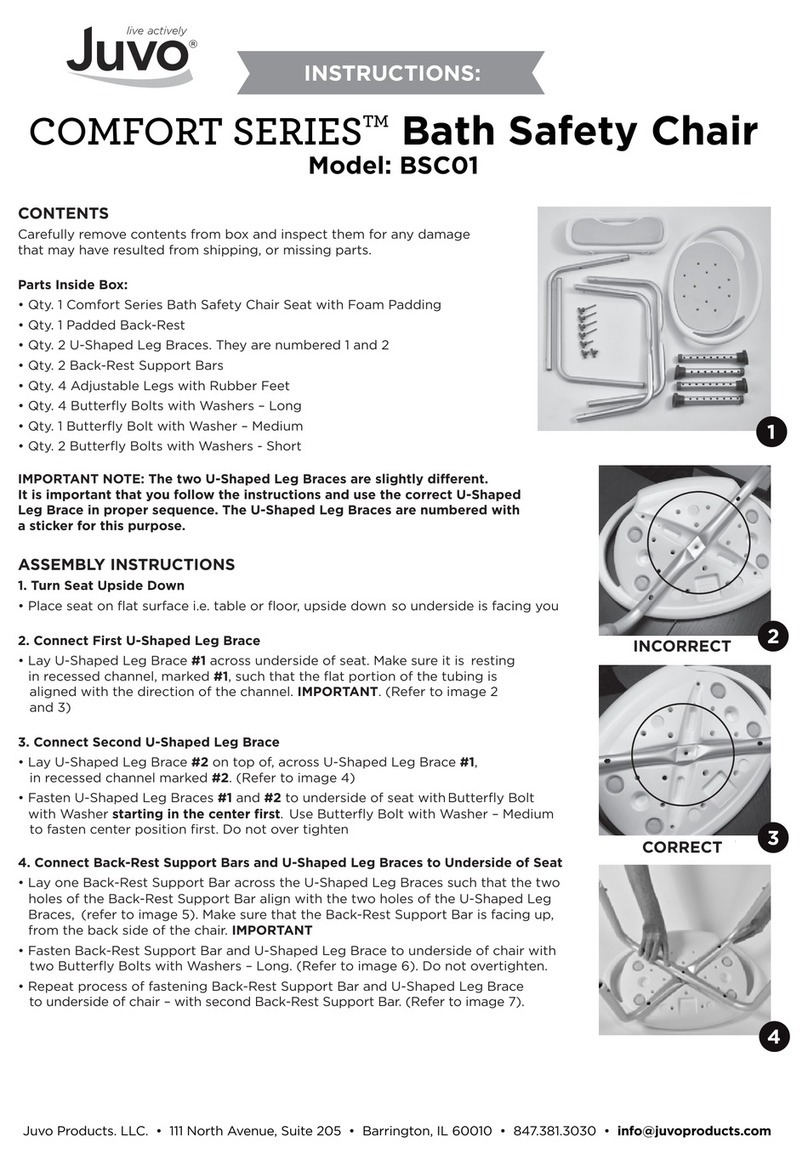Breezy Cirrus G5 User manual

Cirrus G5
User manual
Manual wheelchair MB3171-EN

2 Cirrus G5

Cirrus G5 3
© 2018 Sunrise Medical
All rights reserved.
The information provided herein may not be reproduced and/or published in any form, by print,
photoprint, microlm or any other means whatsoever (electronically or mechanically) without the prior
written authorisation of Sunrise Medical.
The information provided is based on general data concerning the construction known at the time
of the publication of this manual. Sunrise Medical executes a policy of continuous improvement and
reserves the right to changes and modications.
The information provided is valid for the product in its standard version. Sunrise Medical can therefore
not be held liable for any damage resulting from specications of the product deviating from the
standard conguration. Illustrations contained in the manual may deviate from the conguration of your
product.
The information made available has been prepared with all possible diligence, however Sunrise
Medical cannot be held liable for any errors contained in the information or the consequences thereof.
Sunrise Medical accepts no liability for loss resulting from work executed by third parties.
Names, trade names, trademarks etc. used by Sunrise Medical may not, as per the legislation
concerning the protection of trade names, be considered as being available.
The management system of SUNRISE MEDICAL is certied to ISO 9001, ISO 13485 and ISO 14001.
If you have any queries about the use, maintenance or safety of your wheelchair, please contact your
local approved Sunrise Medical service agent.
If you do not know of an approved dealer in your area or have any other questions please write to or
telephone your local Sunrise oce (contact details and web addresses are shown on the back page).

4 Cirrus G5
1 Introduction....................................................................................................................................6
1.1 Congratulations on your new wheelchair 6
1.2 Adjusting the wheelchair 6
1.3 For further information 6
1.4 Symbols used in this manual 6
2 Safety ............................................................................................................................................7
3 General description .......................................................................................................................8
3.1 Assembly 8
3.2 Main components 8
3.3 Intended use and the intended user environment 9
3.4 The user 9
4 Use of the wheelchair..................................................................................................................10
4.1 Quick-release axle 10
4.2 Push bar - height adjustable 10
4.3 Push bar - angle adjustable 11
4.4 Armrests, swing away
- swing up, removing and tting 12
4.5 Swing out/attach/remove the leg supports 13
4.6 Adjusting the legrest angle and the calf support - Angle adjustable legrest 13
4.7 Sliding seat 14
4.8 Using the brakes 14
4.9 Using the attendant brake 14
4.10 Anti-tip stabiliser/tipping bar 15
4.11 Changing the sitting position by adjusting the backrest and seat angle 16
4.12 Moving in and out of the chair 17
4.13 Negotiating obstacles, stairs 18
4.14 Negotiating obstacles 18
5 Settings .......................................................................................................................................19
5.1 Adjusting the seat height 20
5.2 Seat height matrix 22
5.3 Adjusting the brakes 25
5.4 Adjusting the anti-tip stabiliser 25
5.5 Adjusting the neck support 26
5.6 Adjusting the curvature of the backrest 27
5.7 Adjusting the length of the leg supports -angle adjustable leg support 27
5.8 Adjusting the angle of the xed leg supports 27
5.9 Footplate – angle adjustment 28
5.10 Adjusting the seat depth/upper leg length by moving the leg support tting 28
5.11 Adjusting the seat depth/centre of gravity 29
5.12 Adjusting the height of the armrests 30
5.13 Adjusting the depth of the armrest 30
5.14 Adjusting the height of the cloth protector 30
5.15 Fitting the hip belt (accessory) 31
6 Transport .....................................................................................................................................32
6.1 Transport without occupant 32
6.2 Fold the backrest up or down 33
6.3 The wheelchair as a passenger seat in a car 34
6.4 Fastening the seat belt: 35

Cirrus G5 5
7 Maintenance................................................................................................................................38
7.1 Washing the frame 38
7.2 Cleaning the seat and backrest covers 38
7.3 Conditions which may damage the wheelchair 38
7.4 Screws and nuts 38
7.5 Tools for service and driving wheels 38
7.6 Quick-release hub for the wheels 38
7.7 Recommended air pressures 38
7.8 Tools for adjustments 39
7.9 Inspect after six months, and then every year 39
7.10 Repairs 39
7.11 Long-term storage (more than four months) 39
7.12 Changing inated tyres 40
8 Technical specications and dimensions.....................................................................................41
8.1 Lifespan 41
8.2 Handling of waste 41
9 Markings on the wheelchair.........................................................................................................42
10 Warranty......................................................................................................................................43
11 Accessories.................................................................................................................................44
12 Additional Information..................................................................................................................45

6 Introduction Cirrus G5
1 Introduction
1.1 Congratulations on your new
wheelchair
Quality and function are key aspects of all
wheelchairs in the Sunrise series.
For your own safety, and in order for you to get
the best possible benet from the features of
your new wheelchair, we recommend that you
read this user manual carefully before you start
to use the wheelchair.
1.2 Adjusting the wheelchair
The average wheelchair user does not exist.
This is why Sunrise wheelchairs can be
adjusted according to the specic needs of
the user. Settings mentioned in chapter “4 Use
of the wheelchair” can be carried out by the
user. All other adjustments mentioned in this
User manual are to be performed by qualied
personnel or in consultation with qualied
personnel.
1.3 For further information
If you are visually impaired, this document
can be viewed in PDF format at www.
SunriseMedical.com or alternatively is
available on request in large text.
For information about product safety notices
and product recalls, go to www.sunrisemedical.
eu
Please contact your local, authorised SUNRISE
MEDICAL dealer if you have any questions
regarding the use, maintenance or safety of
your wheelchair. In case there is no authorised
dealer in your area or you have any questions,
contact Sunrise Medical either in writing or by
telephone.
1.4 Symbols used in this manual
Note!
Pointing out possible problems to the user.
Caution!
Advice for the user to prevent damage to the
product.
Warning!
Warnings for the user to prevent personal
injury.
Not following these instructions may result
in physical injury, damage to the product or
damage to the environment!
Symbols in illustrations
Each illustration includes icons and numbering
to indicate what needs to be done and in which
order.

Safety 7Cirrus G5
2 Safety
Warning!
• Do not stand, or exert great pressure, on
the footplates.
• A wheelchair should be viewed as a
replacement for walking. Users must
therefore move among pedestrians, not
on roads or streets with motorised trac.
Use reectors when using the wheelchair
outdoors.
• When transferring yourself out of the
chair, take care to ensure that you are on
as stable and even a surface as possible.
To ensure that the chair does not move
when you don’t want it to, check that the
brake is engaged and locked.
• The maximum user weight for Cirrus G5
is 135 kg.
• You should visually inspect the chair
regularly to assure yourself that all
screws, bolts and other xing devices are
securely fastened.
• When the chair is in use, always ensure
that the anti-tip stabiliser is in the correct
position.
• Adjustments of seating or wheel positions
can be set outside safe limit; If any
modications are made to the chair, such
as moving the driving wheels or front
castor wheels, changing the backrest
height etc., this can aect the chair’s
driving characteristics, balance and
tipping point. Exercise particular care
when you start to use the chair again.
• Avoid making modications or alterations
to the chair which may aect the safety
which is built in to the chair’s construction.
• The use of qualied attendants is
recommended when transferring into and
out of the chair.
• Take care that clothes, baggage and other
loose items do not get tangled up in the
wheel spokes.
• Be aware of the possible danger of
crushing injury: avoid putting your ngers
between the clothing guard and the
wheel, between the wheel and the brake,
between the hand rim and the wheel,
between the moving parts on the angle
adjustable legrest and between the side
frame and the leg support attachments
when tilting.
• If while using the chair it is necessary to
raise the front of the chair to negotiate an
obstacle, never do this solely by pressing
down on the pushing handles. Step on the
tipping bar while using moderate pressure
on the pushing handles.
• Sitting in the wheelchair for a long period
of time increases the danger of pressure
sores. If there is a high risk of pressure
sores, we recommend the use of a special
seat cushion to avoid this. Before using
a anti decubitus cushion, check with the
supplier that the cushion can be used on
a at seat surface.
• The surface temperatures can increase
when the wheelchair is exposed to
external sources of heat (e.g. sunlight).

8 General description Cirrus G5
1
2
3 General description
3.1 Assembly
The standard wheelchair is delivered complete.
All you need to do is:
• Fold up the back, see page 33
• Fit the leg supports, see page 13
3.2 Main components
In order to be able to properly understand this
manual, it is important that you are aware of
the common terms used to describe the various
parts of the wheelchair. Examine the drawing
above, and note the relevant parts on your
wheelchair.
The equipment on your wheelchair may vary
slightly from that shown in Figure 1. Where
the wheelchair is set up as an assistant-
manoeuvred chair, it is equipped with dierent
wheel dimensions and a brake lever for the
assistant on the pushing handle.
Backrest and back
cushion
Armrest
Clothes protector
Seat and seat
cushion
Leg support
Footplate
Push bar
Driving wheel
Hand rim
Wheel block
Brake
Bearing housing
for castor
Castor wheel fork
Castor wheel
Headrest

General description 9Cirrus G5
3.3 Intended use and the intended
user environment
Cirrus G5 is designed for both indoor and
outdoor use.
3.4 The user
This wheelchair has been developed for
persons with disabilities and as an aid for
those who have problems with walking. Users
who can control the wheelchair by rolling,
steering and braking it themselves can use the
wheelchair without an assistant. The maximum
user weight is 135 kg. The user must be familiar
with the contents of the user manual before
driving the wheelchair.

10 Use of the wheelchair Cirrus G5
3
4
4 Use of the wheelchair
4.1 Quick-release axle
The wheelchair has a quick-release axle on the
driving wheels. Press the button in the middle
of the driving wheel in order to remove or attach
the wheel.
Note!
Check that the wheel is properly secured
by ensuring that the button pops out
approximately 5 mm when the wheel bolt is
completely in the casing.
4.2 Push bar - height adjustable
Adjusting the height of the push bar
• Loosen the locking handles
at the same
time as pulling the push bar upwards or
pushing it downwards to the desired height.
• Re-tighten the locking handle.
Removing the push bar
For extra safety, the push bar is equipped with
a snap lock in the topmost position.
• To remove the push bar, pull the push bar
to the highest position then squeeze in the
snap lock
.
Warning!
Do not put pressure on the push bar when
negotiating kerbs. Place one foot on the
tipping bar to tilt the wheelchair whilst
steering with the pushing bar. See “4.14
Negotiating obstacles” on page 18.

Use of the wheelchair 11Cirrus G5
5
4.3 Push bar - angle adjustable
Adjusting the angle of the push bar
• Pull the lever
at the same time as angling
the push bar upwards or downwards.
• Release the lever at the desired angle.
Warning!
Do not put pressure on the push bar when
negotiating kerbs. Place one foot on the
tipping bar to tilt the wheelchair whilst
steering with the pushing bar. See “4.14
Negotiating obstacles” on page 18.

12 Use of the wheelchair Cirrus G5
6
7
8
4.4 Armrests, swing away
- swing up, removing and
tting
• In order to swing up the armrest, push the
release lever and pull up the armrest.
• To remove the armrest; swing up the armrest
and pull it up.
• Replace the armrest in reverse order.
Note!
Ensure that the armrest locks into position
when you swing it back down.
Warning!
When removing the armrest be aware of the
potential risk of getting your ngers or clothes
caught in the wheel.

Use of the wheelchair 13Cirrus G5
9
10
11
4.5 Swing out/attach/remove the
leg supports
The procedure is the same for xed and angle
adjustable leg supports.
The leg supports can be swung in/out or
removed in order to make transport and getting
in and out of the chair easier. The leg supports
can be released by twisting the lever
inwards
or outwards.
The leg support can be lifted straight up and
completely removed if desired. In order to
attach it again, carry out these steps in reverse
order, and the handle will lock automatically.
The complete leg support unit and fastenings
can be removed, see “5.10 Adjusting the seat
depth/upper leg length by moving the leg
support tting” on page 28.
4.6 Adjusting the legrest angle
and the calf support - Angle
adjustable legrest
Adjusting the legrest angle
The legrests can be adjusted separately.
• Loosen the lever
• Adjust to desired angle and tighten the lever
Adjusting the calf support
The calf support
can be depth adjusted and
sideways adjusted.
Warning!
Squeezing hazard!

14 Use of the wheelchair Cirrus G5
12
13
14
4.7 Sliding seat
Use the sliding seat function to adjust the seat
depth and to move the seat further forward
when transferring the user.
• Put the seat in a horizontal position
• Push the handle
backwards at the same
time as taking hold of the strap
and
pushing or pulling the seat to the desired
position
Note!
Pull the sliding seat to the fully-forward
position when transferring into and out of the
chair.
4.8 Using the brakes
Pull the brake lever towards you to engage the
brake.
Warning:
The brake is only designed to hold the chair
when it is stationary. Under no circumstances
should it be used as a driving brake.
4.9 Using the attendant brake
• Squeeze the brake lever
to reduce the
speed.
• Push the lever
to activate the parking
brake. Squeeze the brake lever
to release
the parking brake.

Use of the wheelchair 15Cirrus G5
15
4.10 Anti-tip stabiliser/tipping bar
The anti-tip stabiliser is adjusted as standard
with a clearance to the base that makes it
possible to mount doorsteps etc.
Warning
When the chair is in use, always ensure that
the anti-tip stabiliser is in the correct position.
The anti-tip stabiliser is put into position by
turning it backwards.
The tipping bar is accessible when the anti-tip
stabiliser is in or out.

16 Use of the wheelchair Cirrus G5
35°
33°
16
17
4.11 Changing the sitting position
by adjusting the backrest and
seat angle
• Adjust the backrest angle with the right
adjustment lever.
• Tilt the chair with the right adjustment lever.
Note!
For safe adjustment of the sitting position the
assistant should grip rmly on the pushing
handle with one hand, and operate the
adjustment levers with the other hand.
Warning!
The chair might be unstable when the
backrest and the seat are angled in the
backmost position. The anti-tip stabiliser
should be used when the sitting position is
leaning backwards.
Ensure that hands and other body parts are
not squashed when tilting the chair.

Use of the wheelchair 17Cirrus G5
18
19
20
4.12 Moving in and out of the chair
• Activate the brakes
• Swing out or remove the leg supports
• Tilt the chair forwards
• Use the sliding seat before moving out of the
wheelchair, see “4.7 Sliding seat” on page
14.
• The user can now be moved in or out of the
wheelchair by means of manual lifting or a
person lift, or frontal movement if the user
has the ability to stand
For sideways transfer, swing up or remove the
armrest.

18 Use of the wheelchair Cirrus G5
21
22
4.13 Negotiating obstacles, stairs
If the wheelchair is being lifted with the user
sitting in it, the recommended lifting points
should be used. These are marked on the
product.
The lifting points are the cross bar
on the
back and the seat frame
.
In order for assistants to have a better lifting
position, they can alternatively lift from each
side of the wheelchair.
Warning!
Do not lift the wheelchair by:
• The armrests
• The angle adjustable leg supports
• The leg support ttings
• The angle adjustable push bar
4.14 Negotiating obstacles
Kerbs
If necessary swing the anti-tip devices in or up.
When negotiating kerbs etc., place one foot
on either of the tipping bars
whilst steering
with the pushing bar. Tilt the chair backwards
where necessary to get clearance between the
obstacle and leg supports.
Steep terrain
For frequent use in undulating terrain, we
recommend that a separate brake is tted for
an assistant where relevant.

Settings 19Cirrus G5
5 Settings
The average wheelchair user does not exist.
This is why Sunrise Medical wheelchairs can
be adjusted according to the specic needs of
the user.
In this, we make a distinction between
wheelchair settings and wheelchair adjustment
options. Settings are carried out only once
and must be executed by qualied specialists,
unless explicitly stated otherwise. Adjustment
options can be carried out by the user. These
adjustment options do not require the use of
tools.
For an overview of tools carry out settings, see
“7.8 Tools for adjustments” on page 39.
Warning!
Changes to the technical specications of the
wheelchair are not permitted.
Modications to the wheelchair or to any
parts thereof are not permitted.

20 Settings Cirrus G5
23
5.1 Adjusting the seat height
The seat height can easily be adjusted. The
dierent ways of adjusting the seat height also
aect the ability to negotiate obstacles and
rolling properties of the wheelchair.
Warning!
Do not adjust Cirrus G5 so that you have
dierent seat heights at the front and back,
as this can aect the balance point and
driving characteristics.
The seat height can be adjusted by 10 cm
(4 heights) without changing wheels or forks.
The fork bearing can be turned upside down
and spacers can be added for dierent heights
in front. The holes in the wheel-positioning block
gives corresponding adjustment possibilities
for the rear wheels. If further adjustments are
needed, alternative wheel sizes can be used.
Other manuals for Cirrus G5
1
This manual suits for next models
1
Table of contents
Other Breezy Wheelchair manuals

Breezy
Breezy Cirrus G5 User manual

Breezy
Breezy Emineo User manual

Breezy
Breezy EC Transport User manual

Breezy
Breezy Relax2 Manual
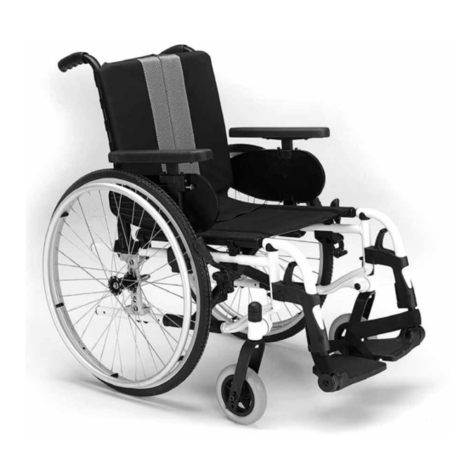
Breezy
Breezy Style X User manual

Breezy
Breezy PariX2 Manual

Breezy
Breezy Ultra 4 Installation and operation manual

Breezy
Breezy Nuage PLS User manual
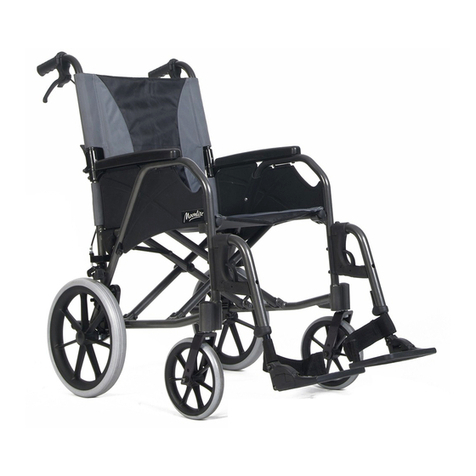
Breezy
Breezy Moonlite Manual
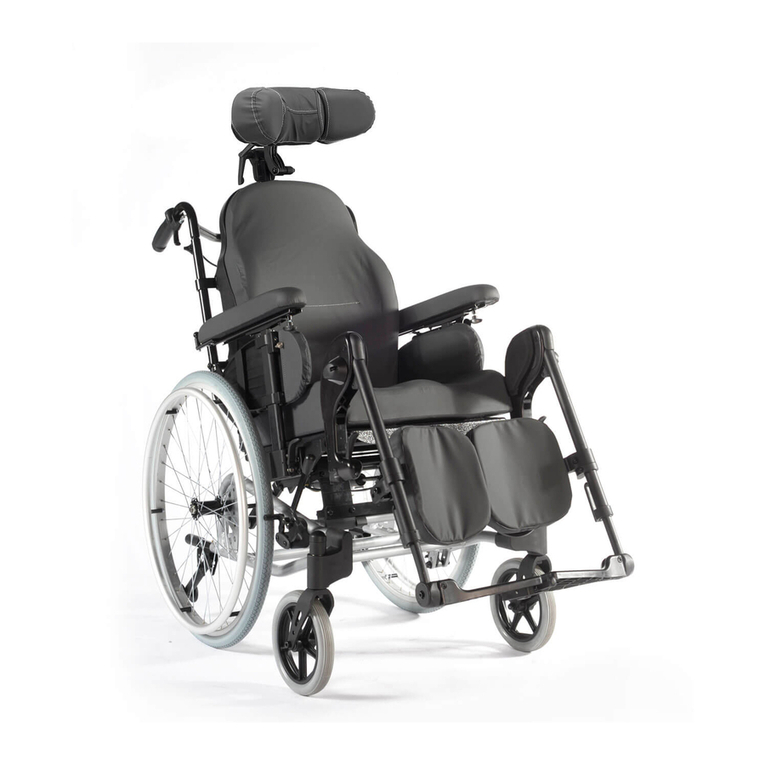
Breezy
Breezy Relax2 Manual
